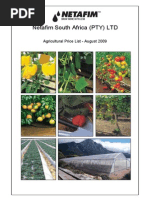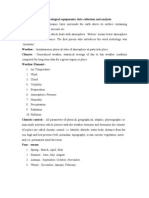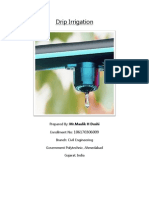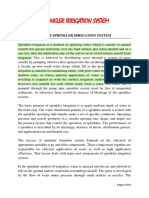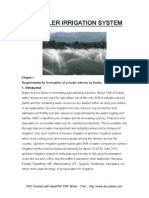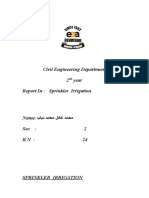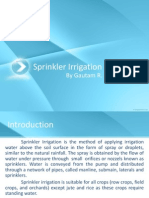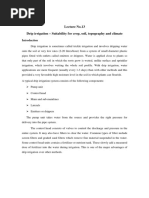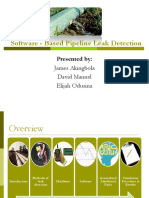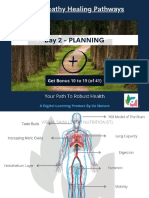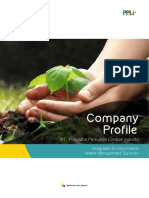SDI Subsurface Drip Irrigation
SDI Subsurface Drip Irrigation
Uploaded by
Arief IhsanCopyright:
Available Formats
SDI Subsurface Drip Irrigation
SDI Subsurface Drip Irrigation
Uploaded by
Arief IhsanCopyright
Available Formats
Share this document
Did you find this document useful?
Is this content inappropriate?
Copyright:
Available Formats
SDI Subsurface Drip Irrigation
SDI Subsurface Drip Irrigation
Uploaded by
Arief IhsanCopyright:
Available Formats
N
Subsurface Drip Irrigation Systems
Advanced
Drip/Micro
Irrigation
Technologies
Subsurface Drip Irrigation
Quality. Dependability. Global Expertise. For over 40 years, growers worldwide have counted on Netafim USA for the most reliable, cost-effective and efficient ways to deliver water, nutrients and chemicals to their crops. This tradition continues with subsurface drip irrigation (SDI), the most advanced method for irrigating agricultural crops. With proper management of water and nutrients, a subsurface drip irrigation system can deliver maximum yields and optimal water use efficiencies. What is Subsurface Drip Irrigation? Subsurface drip irrigation is a variation on traditional drip irrigation where the dripperline (tubing and drippers) is buried beneath the soil surface, rather than laid on the ground. The depth and distances the dripperline is placed depends on the soil type and the plant's root structure. Subsurface Drip Irrigation Advantages. The key benefit of a surface micro-irrigation system is to apply low volumes of water and nutrients uniformly to every plant across the entire field. Subsurface Drip Irrigation delivers many advantages beyond surface irrigation. Drip Irrigation Advantages
Increases production and yields Increases quality and uniformity of crop production Accelerates crop maturity Increased ability to farm marginal land More efficient use of applied water Substantial water savings
Advanced Technologies from the Leaders in Precision Irrigation
Water Movement in Subsurface Drip Irrigation Systems When applied slowly to the soil at a single point, water moves through the soil in two ways: 1) downward pulled by gravity and 2) outward and upward, pulled by capillary action. Subsurface Drip Irrigation Advantages
Eliminates surface evaporation Reduces crop stress Extends life of irrigation system Prevents weed germination Eliminates herbicide wash-out Less salts from efficient irrigation Reduces labor requirements Reduces maintenance costs Safe and efficient delivery of fertilizer and chemicals Reduces animal, human or mechanical damage
The Netafim USA Advantage. Netafim USA offers the widest selection of subsurface drip irrigation products and superior system accessories available in the industry. Designed to work together, a complete system from Netafim USA is made of top-quality products, ensuring a successful subsurface drip irrigation system.
Achieving Success
System Planning in Two Steps
Step 1
Site Evaluation Selecting the Best Emission Device for Your Application Site evaluation is the first step in developing a successful Subsurface Drip Irrigation system - it requires assessments of the water quality and availability, soil and topography. Listed below are some general guidelines to help in the selection of an emission device for your specific application. Heavywall Dripperline Options to Meet the demands of Permanent Crops Heavywall dripperlines are recommended for permanent crop subsurface drip applications: 35 mil tubing thickness or greater (heavywall dripperlines) High-quality drippers designed for long-term applications Recommended depth of burial from 4" to 24" (based on soil type) Topography Field Slope will determine whether a designer selects a pressure compensating or non-pressure compensating dripper: Flat Terrain Economical non-compensating drip irrigation for all flat terrain Large fields with quarter mile runs
Bath Outlet Flow Path widest in the industry
Water Quality and Availability Properly addressing water quality issues often solves most problems associated with the successful operation of the subsurface drip irrigation system: Physical - suspended particles and filtration Chemical - ph iron, bicarbonates, carbonates Biological - bacteria and filtration/chemical treatment Soil Type Soil type and absorption play an important role in determining dripper application. Maintaining a dry soil surface is essential. When water migrates to the surface weeds germinate and compete with the crop for water and nutrients.
Full Length Filter maintains the essential supply of water to the dripper delivering a consistent output of flow Triton X Non-Pressure Compensating Dripperline
Turbonet Technology wider cross-section allows large particles through flow path Heavy Clay Soil Medium Textured Soil Light Textured Soil
Low flow drippers are recommended. Water moves to the soil's surface easily when the dripperline is installed too shallow or if a high flow dripper exceeds the soil's ability to absorb water - resulting in channeling.
Requires closer dripper spacing (compared to clay soil). Lower flow drippers are recommended.
Closer dripper spacing is required in order to uniformly wet the soil profile. High frequency irrigation can be used to achieve similar results.
The Quarter-Mile Solution for Non-Pressure Compensating Drip Irrigation
Root Barrier Cover Interconnecting Locking Mechanism Diaphragm Anti-Siphon Mechanism Turbonet Technology Pressure Compensating Chamber Check No Leakage (CNL) Feature, Optional
Rolling Terrain Pressure compensating dripperline Long runs Applications demanding high uniformity
UniRam Pressure Compensating Dripperline
Large Filtration Area Anti-Siphon Mechanism Self-flushing, Self-Cleaning
System Design
Planning a Quality System Design
Step 2
Getting the Best Return on Your Investment The goal is to get the best return on your investment. A well-designed system quickly pays for itself and adds to your bottom line. Subsurface drip irrigation allows growers to cut labor expenses and more efficiently manage water and nutrients. into the dripper potentially plugging the dripper. Other system design considerations include: Submain positioning - should be placed in the highest location Rolling terrain - requires strategic placement of pressure regulation, vacuum relief and check valves
1" Automatic Continuous Acting Air Vent
Product Selection Making the Right Decision Heavywall dripperlines are available in many different configurations to meet your unique crop and soil conditions. The options you choose will determine the overall cost of the system: Wall thickness - consider planned length of use Tubing size and dripper spacing Dripper type - pressure compensating (undulating terrain) or non-pressure compensating (slopes) Dripper performance - consider product history, physical characteristics of flow path and hydraulic parameters System Components Other factors to consider when planning your system are filtration, vacuum relief and root intrusion protection. Filtration Sand, Disc and Screen Many factors should be considered when selecting a filter system including: flow rate, quality of incoming and discharged water and the type of dripper - the smaller the flow path, the more critical the required filtration.
For high spots where air accumulates.
1" and 2" Combination Vacuum Relief and Continuous Acting Air Vent
For release of large volumes of air at pump and filtration stations, along mains, and at end of mainlines. At high elevations in pipe network and upstream side of manifolds.
1" to 3" Guardian Air and Vacuum Vent
For downstream of valves, and at manifolds to break vacuum caused by system draining. Reliable, Accurate Flow Meters Flow Meters are specifically designed for irrigation systems to provide the most accurate and reliable flow readings. When properly selected and maintained, flow meters can be the most accurate and easiest method for measuring water flow in the pipelines and improving efficiency through accurate application of water.
3", 4, 6, 8, 10 and 12 WST Flow Meters
Plastic, Corrosion Proof
Galaxy Disc-Kleen Filter
AGF Media Filter
High-Flow Water Filtration System
Manual Steel Filter
19000 Series Screen Filter
Pressure Relief with Air Relief and Vaccum Valves Air/vacuum relief vents are an inexpensive protection against soil ingestion and can extend the life of the drippers in the subsurface drip irrigation system. If the system is not properly vented, when the dripperline drains during shutdown, fine soil particles can be ingested
Maximum protection from fine sand damage. Low wear, long-life impeller shaft and bearings. Can be installed in a vertical, horizontal or oblique position.
Netafim USA Delivering Total System Solutions for Agriculture Dripperlines Sprinklers Filters Valves Air Vents Flow Meters Crop Management Technologies
SDI 12/06
You might also like
- Hydroponics Its History and Use in Plant Nutrition Studies PDFDocument29 pagesHydroponics Its History and Use in Plant Nutrition Studies PDFGovind R NairNo ratings yet
- 2021.2022 Grade 4 Topic 4 Earths Features Unit 2 Earth and Space ScienceDocument8 pages2021.2022 Grade 4 Topic 4 Earths Features Unit 2 Earth and Space ScienceMiss LeighhNo ratings yet
- 9 - Drip IrrigationDocument58 pages9 - Drip Irrigationgregorio roaNo ratings yet
- Process - Quality Liposomal CDocument7 pagesProcess - Quality Liposomal Crmans100% (1)
- Netafim Report 1 4 1 PDFDocument85 pagesNetafim Report 1 4 1 PDFJignesh ChaudharyNo ratings yet
- Factors To Consider When Choosing Dripperlines Manual NETAFIMDocument24 pagesFactors To Consider When Choosing Dripperlines Manual NETAFIMCarlos Rovello GandoNo ratings yet
- Drippers Cataloge 2014Document156 pagesDrippers Cataloge 2014Carlos Rovello GandoNo ratings yet
- Netafim Product GuideDocument117 pagesNetafim Product Guideliyameles100% (1)
- Rambutan Improving Yield and QualityDocument69 pagesRambutan Improving Yield and QualitySyukri Abd RahmanNo ratings yet
- GrapesDocument64 pagesGrapesВоја ВојводаNo ratings yet
- Land & Water Management in Africa PDFDocument111 pagesLand & Water Management in Africa PDFAnonymous M0tjyWNo ratings yet
- Agricultural Irrigation - With Information on Water Quantities, Sewage, Reservoirs and Various Methods of IrrigationFrom EverandAgricultural Irrigation - With Information on Water Quantities, Sewage, Reservoirs and Various Methods of IrrigationNo ratings yet
- Oliju Productlist - 2018 - EN PDFDocument31 pagesOliju Productlist - 2018 - EN PDFJose Carlos SoaresNo ratings yet
- Buget de Venituri Si Cheltuieli: S.C. S.R.L. AdministratorDocument1 pageBuget de Venituri Si Cheltuieli: S.C. S.R.L. AdministratorhistoryXNo ratings yet
- Processor Sweet Corn Crop GuideDocument12 pagesProcessor Sweet Corn Crop Guidevictor vianaNo ratings yet
- Strawberry Farm Set UpDocument20 pagesStrawberry Farm Set UpEllis BrossieNo ratings yet
- Barbuto Olive OilDocument10 pagesBarbuto Olive OiljeanpaulmifsudNo ratings yet
- Agro Manual 2014Document28 pagesAgro Manual 2014raducu571408No ratings yet
- Lista de Preturi 2016 RSMDocument3 pagesLista de Preturi 2016 RSMionutzbejanNo ratings yet
- Consumer Behaviour For Wine 2.0Document22 pagesConsumer Behaviour For Wine 2.0Ricardo CunhaNo ratings yet
- Wine Making ProcessDocument12 pagesWine Making ProcessWenny WiraneNo ratings yet
- E J Gello Winery Case AnalysisDocument29 pagesE J Gello Winery Case Analysismileva_lukicNo ratings yet
- Lychee Specialty CropDocument13 pagesLychee Specialty CroprkmNo ratings yet
- NETAFIM Drip Irrigation System HandbookDocument96 pagesNETAFIM Drip Irrigation System HandbookCarlos Rovello GandoNo ratings yet
- What Is Drip ArticleDocument8 pagesWhat Is Drip ArticleGunasridharan LakshmananNo ratings yet
- Agrinext pptDocument39 pagesAgrinext pptDHRUV KUMARNo ratings yet
- SHOCK 2006 Drip Irrigation An IntroductionDocument8 pagesSHOCK 2006 Drip Irrigation An IntroductionMoaed KanbarNo ratings yet
- Hydrology, Irrigation and Flood Management L4/T1 (Civil Engineering Department)Document21 pagesHydrology, Irrigation and Flood Management L4/T1 (Civil Engineering Department)Mirza Md. Nazmus SakibNo ratings yet
- AGR 351 - Micro Irrigation System - PPT 1 - Agri JunctionDocument68 pagesAGR 351 - Micro Irrigation System - PPT 1 - Agri JunctionKavinNo ratings yet
- Drip Irrigation BrochureDocument6 pagesDrip Irrigation BrochureHRagheb100% (1)
- Selecting an Irrigation System- Small Scale Solutions for your FarmDocument4 pagesSelecting an Irrigation System- Small Scale Solutions for your Farmabdom0643No ratings yet
- Summer Training ReportDocument35 pagesSummer Training ReportDeepak Goel60% (5)
- Global Reach and Market Leaders: Netafim Jain IrrigationDocument14 pagesGlobal Reach and Market Leaders: Netafim Jain IrrigationAyush KumarNo ratings yet
- Drip IrrigationDocument8 pagesDrip IrrigationNatesa IndrasenanNo ratings yet
- Study of Drip Irrigation SystemDocument5 pagesStudy of Drip Irrigation SystemSougata DasNo ratings yet
- Value Chain For Watering EquipmentDocument20 pagesValue Chain For Watering EquipmentHaftamuNo ratings yet
- Techniques OF Drip Irrigation and FertigationDocument25 pagesTechniques OF Drip Irrigation and FertigationBhuvnesh Kumar100% (2)
- Cotton ManualDocument40 pagesCotton ManualGregory BakasNo ratings yet
- Pressurized IrrigationDocument14 pagesPressurized Irrigationnigusegebregergs275No ratings yet
- 2005 07 14 IsfDocument7 pages2005 07 14 IsfDonz RahmandaniNo ratings yet
- Sprinkler Irrigation SystemDocument17 pagesSprinkler Irrigation SystemSidNo ratings yet
- Drip Irrigation and Fertigation Drip Irrigation SystemDocument20 pagesDrip Irrigation and Fertigation Drip Irrigation SystemRudra Goud100% (1)
- Irrigation ManagementDocument4 pagesIrrigation Managementanmn123No ratings yet
- Sprinkler Irrigation System Sprinkler Irrigation System Sprinkler Irrigation System Sprinkler Irrigation SystemDocument25 pagesSprinkler Irrigation System Sprinkler Irrigation System Sprinkler Irrigation System Sprinkler Irrigation SystemSafa KardameNo ratings yet
- Drip IrrigationDocument17 pagesDrip IrrigationPriyadarshiniNo ratings yet
- Drip Irrigation - Management and MaintenanceDocument3 pagesDrip Irrigation - Management and Maintenancepfdc GuwahatiNo ratings yet
- Irrigation For Peaches Irrigation Systems For PeachesDocument5 pagesIrrigation For Peaches Irrigation Systems For Peachesamijoski6051No ratings yet
- Micro IrrigationDocument4 pagesMicro IrrigationKowalski2008No ratings yet
- Resume Drip IrrigationDocument9 pagesResume Drip IrrigationNadia SalsabilahNo ratings yet
- Drip Irrigation Design GuideDocument11 pagesDrip Irrigation Design GuideSiva KumaravelNo ratings yet
- step by stepDocument22 pagesstep by stepmuhammadsaad8575255No ratings yet
- Civil Engineering Department 2 Year Report In: Sprinkler IrrigationDocument11 pagesCivil Engineering Department 2 Year Report In: Sprinkler IrrigationMohamed DiabNo ratings yet
- LDL Design GuideDocument18 pagesLDL Design GuidebhupsjangirNo ratings yet
- Sprinkler Irrigation FinalDocument44 pagesSprinkler Irrigation FinalBirjesh Yaduvanshi100% (1)
- Lec.No.13Document6 pagesLec.No.13saumyarawat479No ratings yet
- Drip Irrigation: Drip Irrigation, Also Known As Trickle Irrigation or Micro Irrigation or Localized Irrigation, IsDocument6 pagesDrip Irrigation: Drip Irrigation, Also Known As Trickle Irrigation or Micro Irrigation or Localized Irrigation, IsSougata DasNo ratings yet
- Drip Irrigation Benguet FinalDocument185 pagesDrip Irrigation Benguet Finalcacadcadaan14No ratings yet
- IrrigationDocument8 pagesIrrigationAstha KushwahaNo ratings yet
- Irrigation SystemDocument7 pagesIrrigation System185412No ratings yet
- PRESENTATIONDocument20 pagesPRESENTATIONpinkyNo ratings yet
- Irrigation methodsDocument48 pagesIrrigation methodselayegetaNo ratings yet
- Software Based Leak Detection PresentationDocument51 pagesSoftware Based Leak Detection PresentationArief IhsanNo ratings yet
- GSH-Deepwater Exploration in Indonesia - Challenges and Opportunities - PHEDocument29 pagesGSH-Deepwater Exploration in Indonesia - Challenges and Opportunities - PHEArief Ihsan100% (1)
- Flow AssuranceDocument80 pagesFlow AssuranceArief IhsanNo ratings yet
- Andritz VA TECH HYDRO GFSE-Presentation Harald SchmidDocument18 pagesAndritz VA TECH HYDRO GFSE-Presentation Harald SchmidArief IhsanNo ratings yet
- Spray DryerDocument21 pagesSpray Dryersundhar100% (3)
- 9b. 2013catalogDocument96 pages9b. 2013catalogEny Sri RyNo ratings yet
- Rapid Needs Assesment For Water, Sanitation and HygieneDocument31 pagesRapid Needs Assesment For Water, Sanitation and HygienekittensqueakNo ratings yet
- TSO C72cDocument6 pagesTSO C72cRobert FlorezNo ratings yet
- Problems on Drilling FluidsDocument3 pagesProblems on Drilling Fluidskoongood33No ratings yet
- Liquids - Level 3Document6 pagesLiquids - Level 3demolition squadNo ratings yet
- DLP - Seed TestingDocument9 pagesDLP - Seed Testingbrynpueblos04No ratings yet
- Day 2 Training PlanningDocument106 pagesDay 2 Training PlanningVijay BhaskarNo ratings yet
- Cobain PpliDocument15 pagesCobain Pplipras husein29No ratings yet
- Geography AssignmentDocument9 pagesGeography Assignmenthum aur hamari lifeNo ratings yet
- ASTMDocument2 pagesASTMNeinelia GuerraNo ratings yet
- Tamol MsdsDocument10 pagesTamol MsdsAbhijith UrumiseNo ratings yet
- What We LearnDocument42 pagesWhat We Learn木辛耳总No ratings yet
- 1st Book ReviewDocument6 pages1st Book ReviewViraj PuramNo ratings yet
- SDS Gta 733Document12 pagesSDS Gta 733harlendri STNo ratings yet
- Nur Sarah Hannis - Exp3Document1 pageNur Sarah Hannis - Exp3Sarah HannisNo ratings yet
- IdrasoftDocument36 pagesIdrasoftemanuelluca@yahoo.comNo ratings yet
- Ch06Document24 pagesCh06Crysthian EcathosNo ratings yet
- MSDS PermaClean PC-33Document10 pagesMSDS PermaClean PC-33evgdamNo ratings yet
- Cooling Tower FundamentalsDocument17 pagesCooling Tower FundamentalsGaurav RathoreNo ratings yet
- TICKO FLOOD IN JAKARTA (Uts)Document2 pagesTICKO FLOOD IN JAKARTA (Uts)TiekoNo ratings yet
- Abandoned ReportDocument30 pagesAbandoned ReportCristian Jesus Peinado PachecoNo ratings yet
- Foreword: M.L. Mehta Deputy Chairman RmolDocument17 pagesForeword: M.L. Mehta Deputy Chairman RmolYachna S. ChandraNo ratings yet
- Water Supply and Sanitation Training ManualDocument93 pagesWater Supply and Sanitation Training ManualMisuari AbdullahNo ratings yet
- Coca-Cola Vs PepsicoDocument38 pagesCoca-Cola Vs PepsicoJenishNo ratings yet
- 1st Monthly Exam in Science 2023Document13 pages1st Monthly Exam in Science 2023Darwin MolinaNo ratings yet
- Cdi6 Module 2Document7 pagesCdi6 Module 2SamuelNo ratings yet
- NTPC Report FinalDocument165 pagesNTPC Report FinalShankar ChowdhuryNo ratings yet







